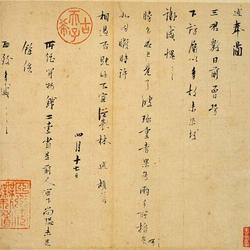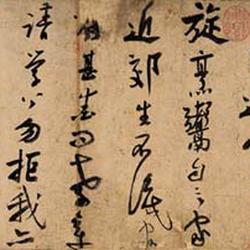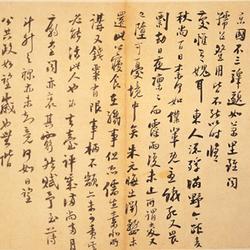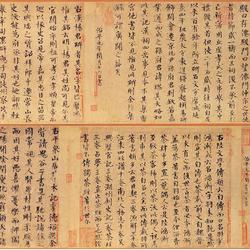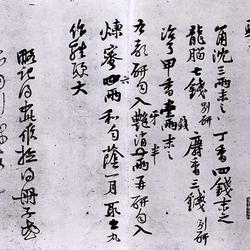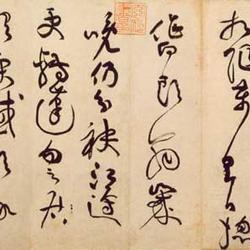"Five Poems on the Pine Fan", running script, paper, 32 cm vertical, 320.6 cm wide, 34 lines, each line has a different number of words, totaling 285 words.
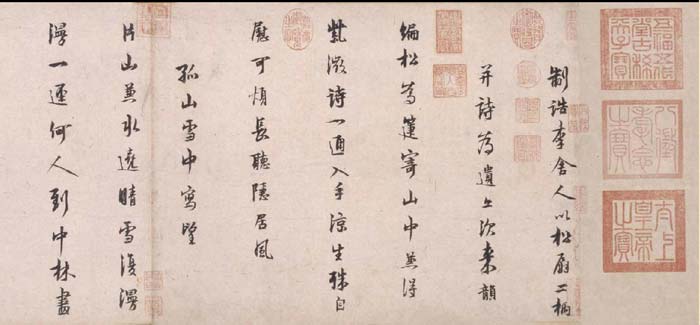
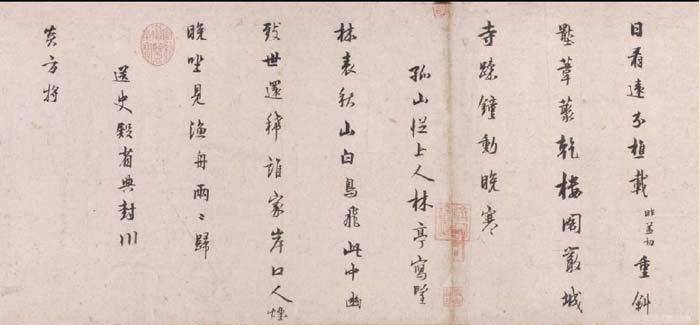
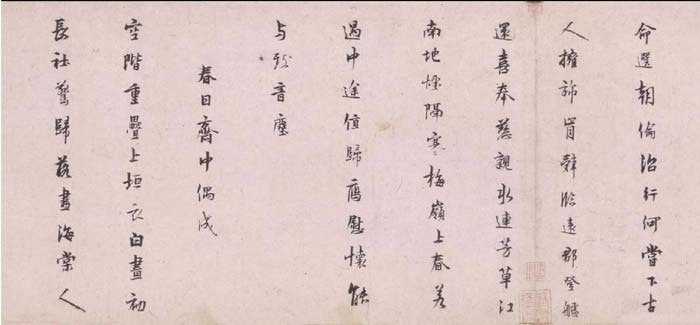
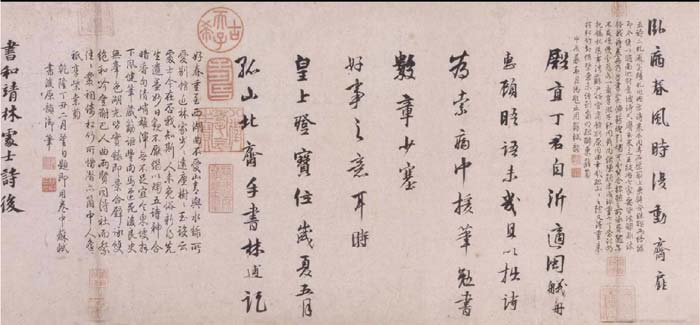
Explanation:
Li Sheren, who made the imperial edict, used two pine fan handles and a poem as the last rhyme. Weaving pine trees into baskets and sending them to the mountains, we also received a poem from Zi Wei. Start masturbating with Liang Shengshu, but you can listen to the wind of seclusion for a long time.
There are five five-character and seven-character poems in this volume, namely "Pine Fan", "In the Snow on Solitary Mountain", "Pine Pavilion on Solitary Mountain", "Farewell to History" and "Spring Day". Lin Bu died in the sixth year of Tiansheng reign of Emperor Renzong of Song Dynasty (1028). This work is inscribed with "Lin Bu's Notes handwritten by Gushan Beizhai in the summer of May when the emperor ascended the throne." It is known that this volume was written in the first year of Tiansheng, Renzong of the Song Dynasty (1023), when Lin Bu was fifty-seven years old.
Lin Bu was famous for his poetry and lived in seclusion all his life. The writing style of this book's poems is thin, strong and strong, with a unique style. When starting the pen, the side edge is often used, and the edge is often exposed. Although there is a hidden edge to close the pen, the edge is more exposed, and there are also exposed edges in the shadows, so you don't want to hide the corner of the pen. As a result, his writing style becomes more solitary and upright. Lin Bu was born in the early Song Dynasty, later than Li Jianzhong. Commentators often say that "Lin Bu hurts thinness, and Jianzhong hurts fatness." In fact, Yan is thin and fat, and each has its own appearance. The book is a body and cannot be specialized. You must use your pen and bone strength. Those who are good at pen strength have many bones. The more expensive the book is, the thinner it is, the harder it is, the more it can lead to spiritual enlightenment. It is better to be thinner and harder than to be too barbaric. But the power of the pen cannot be generalized. Although Lin and Li have different calligraphy styles, they both have bones in their characters. Lin Shu is thin but not withered, and he is happy to have gained the Dharma. The font is slightly longer and slightly tilted to the lower right, similar to Li Jianzhong's "Tumu Tie". But Lin's calligraphy is thin and straight, and the knots are particularly strong. There is one word for "ear" in the scroll and six characters for "中", all with hanging needles in the long and vertical strokes. The six characters for "人" (人), enter with a sideways edge and come out with an exposed edge; enter with a hidden edge and come out with a hidden edge. The spirit is clear and the bones are cold, and the aura is extraordinary. The calligraphy of the Song Dynasty was greatly influenced by Yang Ningshi, a calligrapher of the Five Dynasties. The writing style was often indulgent and unrestrained. The simple calligraphy of the Song Dynasty was particularly influenced by Yang's "Leek Flower Calligraphy". This volume has extremely wide spacing, and two lines of the same typeface can be written between the lines. The spacing between the characters is sparse, the characters are clear and vigorous, full of vitality and spirit, and extremely casual and elegant.
At the back of the volume, there are poems and postscripts written by Su Shi. The seven-character ancient poem fully praises Lin Bu's poems, books and character. The volume also contains four layers of rhymes by Hongli (Qianlong), as well as ten paragraphs of postscripts by Wang Shizhen, Wang Shimao, Wang Hongxu, and Dong Gao. There is a line in the postscript of Su Shi's poems: "The poems are like the cold fields in the east, and the books are like the letters left in Taiwan." Less meat." Lin Shu is indeed like his poem, "the beauty of the plum blossoms" is similar to the lines of "the sparse shadows are slanting" and "the subtle fragrance is floating", but have the same purpose.

